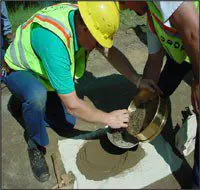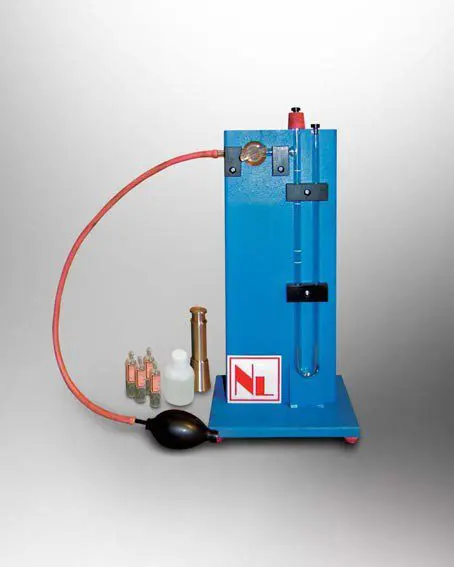Cement acts as a binding material which helps in keeping sand and coarse aggregates together. It helps in filling the voids between sand and coarse aggregates to form a compact dense mass.
Important properties of cement and Tests to evaluate them
1. Fineness
The fineness of cement is a measure of the size of particles of the cement. It is expressed in the term of specific surface area (cm2/g).
It is an important factor in determining the rate of gain of strength and uniformity in quality.
The finer the cement greater is the surface area for the chemical reaction and thus greater is the rate of hydration and also is the greater heat of the hydration. This results in the early development of strength.
But one should be careful that cement should not be grounded beyond a certain limit as it may absorb moisture from the atmosphere and forms a slightly stiffened mass. This is called flash set.
Tests performed for Checking Fineness
- Sieve test [IS: 4031 (Part 1)]
It is not a modern test. In this cement is passed through 90-micron sieve and the residue left on the sieve should not be more than 10 percent.

- Air permeability test [IS: 4031 (Part 2)]
This test is better than sieve test and gives an idea of uniformity of fineness.
In this compressed air is passed through cement and the pressure difference between the incoming air and the outgoing one is related to the specific surface area.
Specific surface area of the Ordinary Portland cement (OPC) should not be less than 2250 cm2/g and for rapid hardening cement should not be less than 3250 cm2/g.

2 : Consistency
[IS: 4031 (Part 4)]
The term consistency is used to indicate the ability of cement paste to deform with the change in water content.
But consistency test is carried out as it is used as an indicator test for several tests like setting time and soundness.
The consistency test is used to determine the water required for testing Initial Setting Time and Final Setting Time tests.
Vicat Test To Determine Consistency
Standard consistency is used to find out the water content at which the Vicat plunger of diameter 10 mm will penetrate the standard mould of size 40 mm by 33-35 mm.

3. Setting time
[IS: 4031 (Part 5)]
Setting time is used to find the extent of deterioration caused due to storage of cement.
Test#1. Initial Setting Time
Initial setting time is defined as the time which is measured from the instant at which water is added to cement and at the time at which cement starts loosing its plasticity.
For carrying out this test, the mould is prepared by adding 85 percent of the water required to achieve standard consistency (0.85p). Then square needle of size 1mm is inserted into the mould and noting the time required by the needle to penetrate 33-35 mm. This time is reported as initial setting time.
Test#2. Final Setting Time
It is the time taken from the instant of adding water to the time at which cement becomes sufficiently stiff to loose all of its plasticity and resists definite pressure.
For carrying out this test mould is prepared by mixing 85 percent of the water required for the standard consistency. The needle with annular collar is lowered down and the time at which collar fails to make the impression and the needle does make is reported as final setting time.
| Types of cement | Initial setting time | Final setting time |
|
OPC (all grades) Rapid Hardening Cement Low heat cement |
30 minutes 5 minutes 60 minutes |
600 minutes 30 minutes 600 minutes |
4. Soundness
[IS: 4031 (Part 2)]
Due to some of the constituents of raw materials of cement like lime (CaO), magnesia (MgO) and sulphur (mainly in form of SO3) cement may undergo undesirable expansion after getting set and this may lead to the cracking and disintegration of concrete and thus causing brittle failure of concrete.
As sulphur is invariably found in the system so we cannot negotiate the unsoundness caused due to it.
So we mainly focus ourselves on the unsoundness caused due to lime and magnesia. For sulphur, we use Portland slag cement.
Test#1: Le Chatelier’s Instrument
The cement in this mould is prepared by adding 78 percent of the water required for the standard consistency.
In the first stage, the mould is placed in water at 27 ○C to 32 ○C for 24 hours and noting the difference between indicators arms. Let it be ‘x’ mm.
Thereafter mould is immersed in water and the temperature of the mould is increased to the boiling temperature in 30 minutes and maintained for next one hour. Then the assembly is taken out and the distance between indicator arms is again noted down. Let it be ‘y’ mm.
y – x should not be greater than 10 mm.
This test is used for finding unsoundness due to lime only.

test#2. Autoclave Aparatus
This is used for finding unsoundness occurring due to both lime and magnesia.
In this square mould of cement paste is prepared with 78 percent of the water required for that of the standard consistency.
After the cement is hardened it is extracted out of the mould and then put into the autoclave apparatus. The pressure inside the apparatus is increased to 21 kg/cm2 in one hour and maintained the same for three hours.
Change in the sides of the mould should not be more than 0.8 percent.

– Manish Anand





